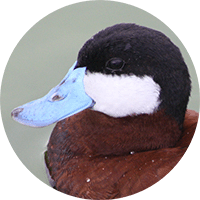Ruddy Duck
Appearance: Ruddy Ducks have a compact body shape (41 cm -16 inches) with a short neck and broad, rounded tail. In breeding plumage, males possess vivid chestnut bodies, black caps, white cheeks, and bright blue bills. Spiky tail often held up. Outside of the breeding season, males resemble females, which have a drab gray-brown plumage with pale cheeks. Females have a single dark stripe on sides of head.
Habitat: Ruddy Ducks inhabit freshwater bodies such as wetlands, marshes, lakes, reservoirs, and slow-moving rivers. They can also adapt to brackish water habitats. These ducks typically prefer areas with abundant vegetation and emergent marsh grasses.
Behavior: Ruddy Ducks are highly skilled divers and spend a significant amount of time underwater, feeding on aquatic plants, seeds, insects, and small crustaceans. They use their lobed toes to paddle efficiently and their wings to propel themselves through the water. On land, they are clumsy due to their feet being positioned so far back on their bodies. Conspicuous often with other waterfowl. Forage by diving.
Breeding: Ruddy Ducks are known for their unique courtship display, which includes males performing vigorous head-bobbing motions and producing distinctive popping or bubbling sounds. They form monogamous pairs during the breeding season. Nesting occurs in dense vegetation near water, including emergent vegetation or in abandoned muskrat houses. The female constructs a well-concealed nest using plant material and down feathers. Clutch size ranges from 6 to 15 eggs, which hatch after an incubation period of around 25 days.
Conservation: The Ruddy Duck is listed as Least Concern by the International Union for Conservation of Nature (IUCN).
Distribution
The Ruddy Ducks can be found in the Island of Providencia as a visitor.
Taxonomy
- Kingdom: Animalia
- Phylum: Chordata
- Class: Aves
- Order: Anseriformes
- Family: Anatidae
- Genus: Oxyura
- Species: Oxyura jamaicensis
The Ruddy Duck is classified under the species Oxyura jamaicensis. The specific name, jamaicensis, reflects the initial type locality of Jamaica, where the species was first described. However, Ruddy Ducks have a widespread distribution across the Americas. The taxonomic classifications may change as new scientific discoveries and research provide further insights into the relationships between species.
Vocalizations
Whistling Calls: Male Ruddy Ducks produce a distinct whistling call, often described as a "kuk-kuk-kuk" or a rapid, high-pitched "wee-wee-wee" sound. These calls are primarily used to attract females and establish territorial boundaries.
Grunting Calls: In addition to the whistling calls, male Ruddy Ducks may emit a variety of low-pitched grunts during courtship. These grunts may have different lengths and patterns and are typically produced during aggressive displays or interactions with other males.
Whining Calls: Ruddy Duck ducklings produce whining calls, which are higher-pitched and softer vocalizations. These calls serve as contact calls to communicate with their parents or siblings.




